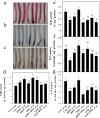Transcriptome analysis reveals insight into molecular hydrogen-induced cadmium tolerance in alfalfa: the prominent role of sulfur and (homo)glutathione metabolism
- PMID: 32019510
- PMCID: PMC7001311
- DOI: 10.1186/s12870-020-2272-2
Transcriptome analysis reveals insight into molecular hydrogen-induced cadmium tolerance in alfalfa: the prominent role of sulfur and (homo)glutathione metabolism
Abstract
Background: Hydrogen gas (H2) is hypothesised to play a role in plants that are coping with stresses by regulating signal transduction and gene expression. Although the beneficial role of H2 in plant tolerance to cadmium (Cd) has been investigated previously, the corresponding mechanism has not been elucidated. In this report, the transcriptomes of alfalfa seedling roots under Cd and/or hydrogen-rich water (HRW) treatment were first analysed. Then, the sulfur metabolism pathways were focused on and further investigated by pharmacological and genetic approaches.
Results: A total of 1968 differentially expressed genes (DEGs) in alfalfa seedling roots under Cd and/or HRW treatment were identified by RNA-Seq. The DEGs were classified into many clusters, including glutathione (GSH) metabolism, oxidative stress, and ATP-binding cassette (ABC) transporters. The results validated by RT-qPCR showed that the levels of relevant genes involved in sulfur metabolism were enhanced by HRW under Cd treatment, especially the genes involved in (homo)glutathione metabolism. Additional experiments carried out with a glutathione synthesis inhibitor and Arabidopsis thaliana cad2-1 mutant plants suggested the prominent role of glutathione in HRW-induced Cd tolerance. These results were in accordance with the effects of HRW on the contents of (homo)glutathione and (homo)phytochelatins and in alleviating oxidative stress under Cd stress. In addition, the HRW-induced alleviation of Cd toxicity might also be caused by a decrease in available Cd in seedling roots, achieved through ABC transporter-mediated secretion.
Conclusions: Taken together, the results of our study indicate that H2 regulated the expression of genes relevant to sulfur and glutathione metabolism and enhanced glutathione metabolism which resulted in Cd tolerance by activating antioxidation and Cd chelation. These results may help to elucidate the mechanism governing H2-induced Cd tolerance in alfalfa.
Keywords: (homo)glutathione; Cadmium; Medicago sativa; Molecular hydrogen; RNA-Seq.
Conflict of interest statement
The authors declare that they have no competing interests.
Figures







References
-
- Sanadze GA. Absorption of molecular hydrogen by green leaves in light. Fiziol Rast. 1961;8:555–559.
MeSH terms
Substances
Grants and funding
LinkOut - more resources
Full Text Sources

